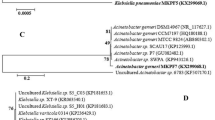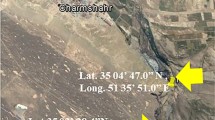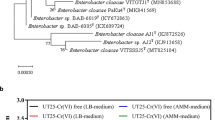Abstract
Two chromium-resistant bacteria (IFR-2 and IFR-3) capable of reducing/transforming Cr(VI) to Cr(III) were isolated from tannery effluents. Isolates IFR-2 and IFR-3 were identified as Staphylococcus aureus and Pediococcus pentosaceus respectively by 16S rRNA gene sequence analyses. Both isolates can grow well on 2,000 mg/l Cr(VI) (as K2Cr2O7) in Luria-Bertani (LB) medium. Reduction of Cr(VI) was found to be growth-associated in both isolates and IFR-2 and IFR-3 reduced 20 mg/l Cr(VI) completely in 6 and 24 h respectively. The Cr(VI) reduction due to chromate reductase activity was detected in the culture supernatant and cell lysate but not at all in the cell extract supernatant of both isolates. Whole cells of IFR-2 and IFR-3 converted 24 and 30% of the initial Cr(VI) concentration (1 mg/l) in 45 min respectively at 37°C. NiCl2 stimulated the growth of IFR-2 whereas HgCl2 and CdCl2 significantly inhibited the growth of both isolates. Optimum temperature and pH for growth of and Cr(VI) reduction by both isolates were found to be between 35 and 40°C and pH 7.0 to 8.0. The two bacterial isolates can be good candidates for detoxification of Cr(VI) in industrial effluents.






Similar content being viewed by others
References
McLean J, Beveridge TJ (2001) Chromate reduction in Pseudomonad isolated from a site contaminated with chromate copper arsenate. Appl Environ Microbiol 67:1076–1084
Rai D, Sass BM, Moore DA (1987) Chromium(III) hydrolysis constants and solubility of chromium(III) hydroxide. Inorg Chem 26:345–349
Yang J, Minyan H, Wang G (2009) Removal of toxic chromate using free and immobilized Cr(VI)-reducing bacterial cells of Intrasporangium sp. Q5-1. World J Microbiol Biotechnol 25:1579–1587
Camargo FAO, Bento FM, Okeke BC, Frankenberger WT (2003) Chromate reduction by chromium-resistant bacteria isolated from soils contaminated with dichromate. J Environ Qual 32:1228–1233
Shen H, Yi-Tin W (1993) Characterization of enzymatic reduction of hexavalent chromium by Escherichia coli ATCC 33456. Appl Environ Microbiol 59(11):3771–3777
Wang PC, Mori T, Komori K, Sasatsu M, Toda K, Ohtake H (1989) Isolation and characterization of Enterobacter cloacae strain that reduces hexavalent chromium under anaerobic conditions. Appl Environ Microbiol 55:1665–1669
Bopp LH, Chakrabarty AM, Ehrlich HL (1983) Chromate resistance plasmid in Pseudominas fluorescens. J Bacteriol 155:1105–1109
Ganguli A, Tripathi AK (2002) Bioremediation of toxic chromium from electroplating effluent by chromate reducing Pseudomonas aeruginosa A2Chr in two bioreactors. Appl Microbiol Biotechnol 58:416–420
Sambrook J, Fritsch EF, Miniatis T (1989) Molecular cloning: a laboratory manual, 2nd edn. Cold Spring Harbor Laboratory Press, Cold Spring Harbor
Ovreås L, Forney L, Daae FL, Torsvik V (1997) Distribution of bacterioplankton in meromictic lake Saelenvannet, as determined by denaturing gradient gel electrophoresis of PCR amplified gene fragments coding for 16S rRNA. Appl Environ Microbiol 63:3367–3373
Altschul SF, Gish W, Miller W, Myers EW, Lipman DJ (1990) Basic local alignment search tool. J Mol Biol 215:403–410
Bartlett RJ, James BR (1996) Chromium. In: Sparks DL (ed) Methods of soil analysis, Part 3, SSSA Book Series 5. SSSA, Madison, pp 683–701
Camargo FAO, Okeke BC, Bento FM, Frankenberger WT (2003) In vitro reduction of hexavalent chromium by a cell-free extract of Bacillus sp. ES29 stimulated by Cu2+. Appl Microbiol Biotechnol 62:569–573
Thacker U, Madamwar D (2005) Reduction of toxic chromium and partial localization of chromium reductase activity in bacterial isolate DM1. World J Microbiol Biotechnol 21:891–899
Wang PC, Mori T, Toda K, Ohtake H (1990) Membrane associated chromate reductase activity from Enterobacter cloacae. J Bacteriol 172:1670–1672
McLean SJ, Beveridge TJ, Phipps D (2000) Isolation and characterization of a chromium-reducing bacterium from a chromated copper arsenate-contaminated site. Environ Microbiol 2(6):611–619
Basu M, Bhattacharya S, Paul AK (1997) Isolation and characterization of chromium-resistant bacteria from tannery effluents. Bull Environ Contam Toxicol 58:535–542
Suzuki T, Miyata N, Horitsu H, Kawai K, Takamizawa K, Yutaka Tai Y, Okazaki M (1992) NAD(P)H-dependent chromium(VI) reductase of Pseudomonas ambiga G-1.: a Cr(V) intermediate formed during the reduction of Cr(VI) to Cr(III). J Bacteriol 174:5340–5345
Shuttleworth KL, Richard FU (1993) Sorption of heavy metals to the filamentous bacterium Thiothrix strain Al. Appl Environ Microbiol 59:1274–1282
Lovely DR, Philips EJP (1994) Reduction of chromate by Desulfovibrio vulgaris and its C3 cytochrome. Appl Environ Microbiol 60:726–728
Ramírez-Díaz MI, Díaz-Pérez C, Vargas E, Riveros-Rosas H, Campos-García J, Cervantes C (2008) Mechanisms of bacterial resistance to chromium compounds. Biometals 21:321–332
Acknowledgment
This work was supported with grant in aid by the Ministry of Science and Information and Communication Technology, Government of the People’s Republic of Bangladesh.
Author information
Authors and Affiliations
Corresponding author
Rights and permissions
About this article
Cite this article
Ilias, M., Rafiqullah, I.M., Debnath, B.C. et al. Isolation and Characterization of Chromium(VI)-Reducing Bacteria from Tannery Effluents. Indian J Microbiol 51, 76–81 (2011). https://doi.org/10.1007/s12088-011-0095-4
Received:
Accepted:
Published:
Issue Date:
DOI: https://doi.org/10.1007/s12088-011-0095-4




